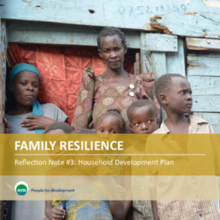Question of Study: How, in practice, were Household Development Plans used, and what was their value in improving the relationship environment and capacities of families to reintegrate previously separated children and youth back at home and to prevent separation?
This question was considered very important for the AVSI Uganda staff because of the recent and powerful experience with the SCORE project in which each household prepared a Household Development Plan (HDP) tailored to the available resources and potential already existing within each household. The tool proved very useful as a guide for project interventions that were aimed to make a person aware of their value and resources, and to become self-reliant and capable of coping with any circumstances. The HDP methodology was essential to SCORE’s family centered approach which supported the child protection aims of the SCORE project for Orphans and Vulnerable Children.
In contrast to SCORE, in the Family Resilience (FARE) project (a project of ASPIRES) there were two entry points and specific populations targeted: children already separated and living on the streets or in child care institutions, and children in households at risk of child-family separation.
Household Development Plans (HDPs) are a case management tool used to assess household needs and household resources and capacities to plan the necessary actions required to lead the household out of vulnerability. Trained staff use these tools in order to coach and accompany a family. Each HDP is tailored to the individual family. A successful plan, in addition to supporting the family in achieving a stable and decent standard of living, also aims to prevent child separation or prepare the family for child reintegration.
Read also:

